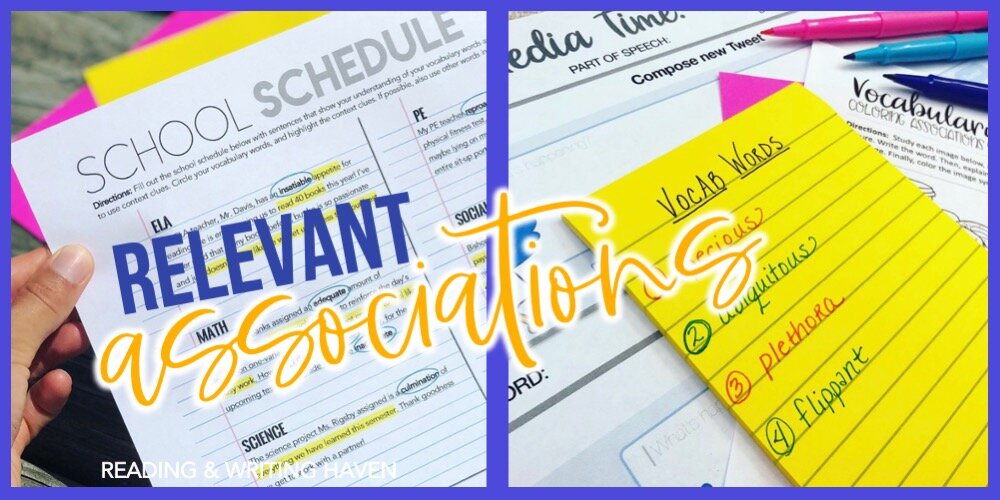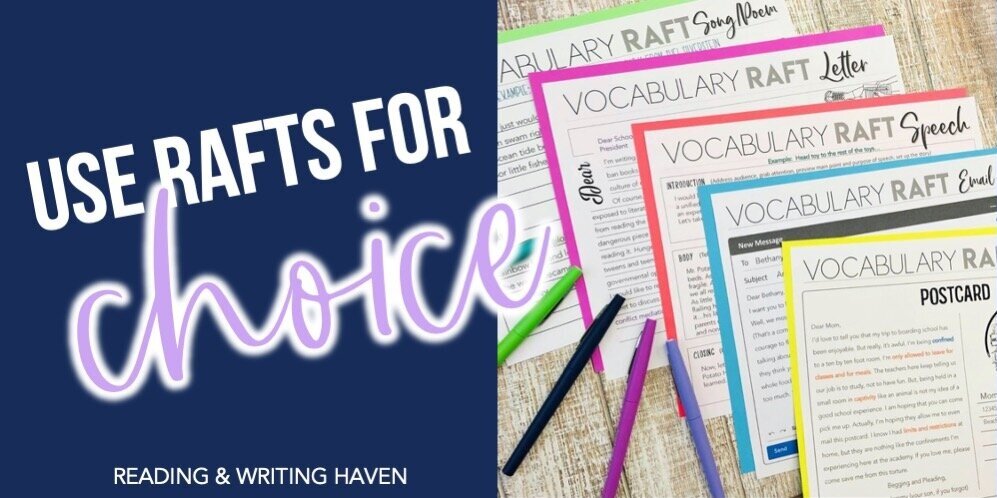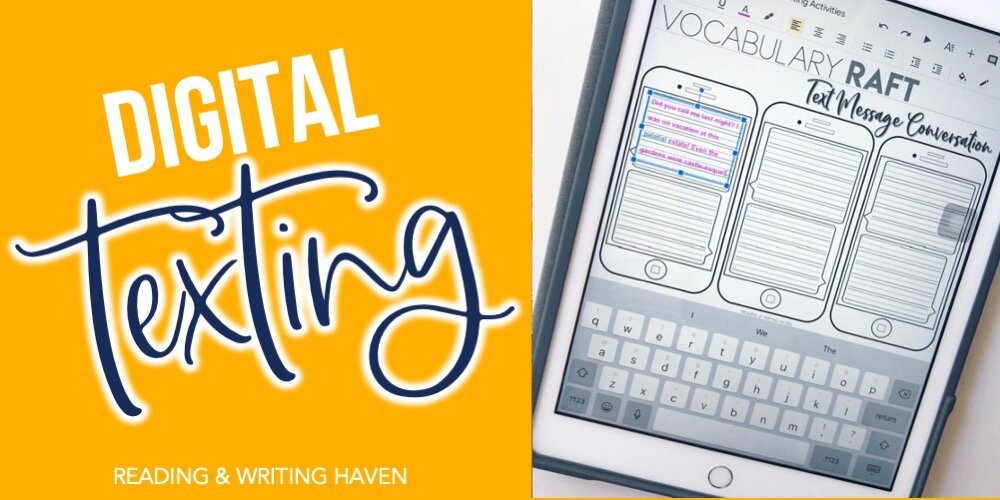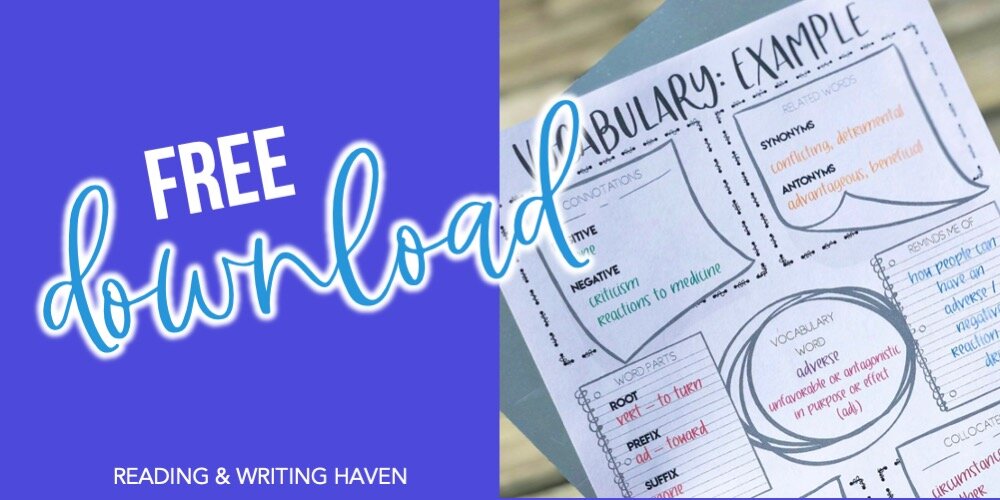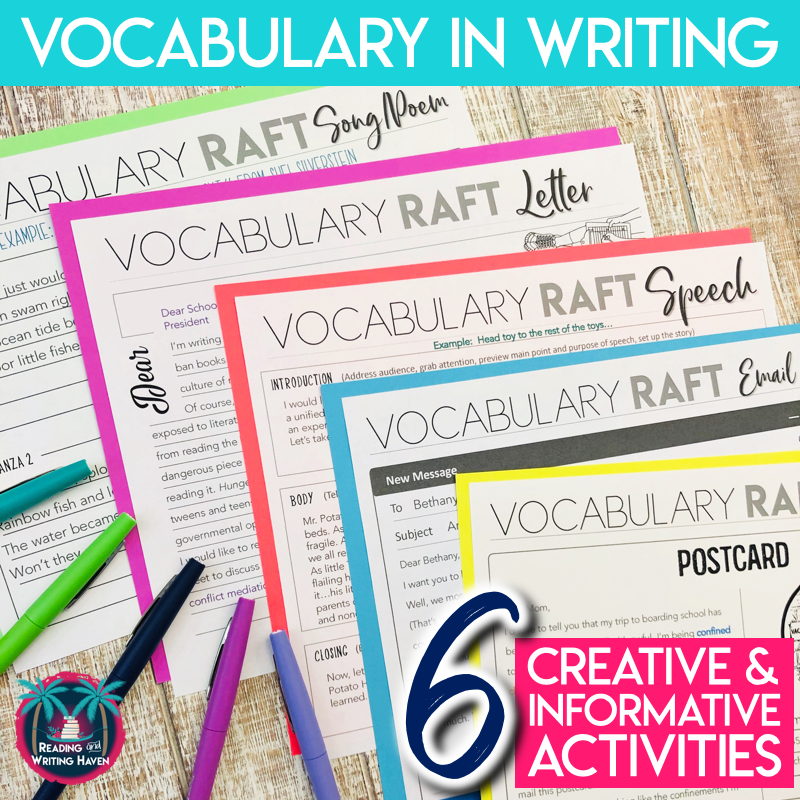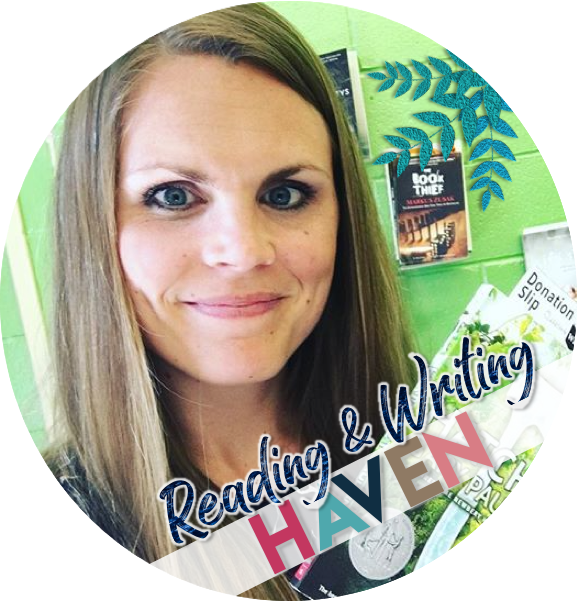5 Ways to Incorporate Vocabulary in Writing
…fun vocabulary writing activities for middle and high school ELA…
Teachers often want students to incorporate vocabulary in their writing. The whole purpose of vocabulary instruction is to expand students’ spoken and written vernacular. We can ask students to use their vocabulary in sentences or in stories, but those approaches are expected. In this post, let’s look at some less traditional methods for helping students not only understand their words at a deeper level, but also use them in writing with context clues.
Method 1: WORD POEMS
Diamantes are relatively easy to write. Students write the vocabulary word on the first line and a synonym or (for an added challenge) antonym on the last line. The lines in between have various types of context clues. Here is an example:
sepulcher
dark, gloomy
enshrining, mourning, honoring
grave, catacomb, crypt, repository
entombing, mummifying, burying
grievous, lamentable
monument
As students create their diamantes, which seem simple, you will notice that many of them will choose to use a thesaurus. In order to come up with related adjectives, verbs, and nouns, students will need to get creative and explore synonyms. This experience deepens their vocabularies and associations with the words.
Ready to take it further? Ask students to write a paragraph explaining how the words in their diamante contribute to the positive or negative connotations of the original vocabulary word(s). For instance, most of the words in the example poem lean more toward a negative, depressing view of death. It makes us think of someone who lived an honorable life which, perhaps, ended too soon.
Method 2: SCHOOL ASSOCIATIONS
Have students apply their vocabulary words to sentences about other classes. Why? This writing activity brings more meaningful connections than asking students to write random sentences, which they normally end up finding or adapting from online, anyway. Let’s take a look at what this might mean for a few SAT vocabulary words:
In Math, Mrs. Banks assigned an adequate amount of homework. It was just enough practice to reinforce the day’s lesson on one-variable equations, but not enough to feel like busy work.
The science project Ms. Rigsby assigned is a culmination of everything we have learned this semester. Thank goodness we get to work with a partner!
Our ELA teacher, Mr. Davis, has an insatiable appetite for reading. He is encouraging us to read 40 books this year!
After students write their associations, which, you may notice, can also be longer than one sentence, encourage them to draw pictures. What does an average amount of homework look like? What science concepts are involved in a culminating project? What would Mr. Davis look like if his appetite for books were insatiable?
Care to enrich the assignment? Have students write a little bit more for each word, incorporating different parts of speech or word patterns. To illustrate:
I did not adequately study for the math exam. Mrs. Banks did give us an adequate amount of homework during the course of the unit, but I didn’t complete it all diligently. As a result, my test score makes me feel inadequate.
If your students need practice with identifying word families, word parts, and related words, make sure to grab this free vocabulary resource.
Method 3: RAFTS
RAFTs are a fun way to get students writing in different genres. If you’ve never used them before, the basic premise is to assign students a point of view from which to write, an audience, a format, a topic. For instance, students might use their vocabulary words in this situation:
Role: Shark
Audience: Fish of the Sea
Format: Apology Letter
Topic: Sending condolences for eating so many of their friends; plans to adopt a stringent vegetarian diet
Maybe condolences and stringent are the vocabulary words students are most focused upon, but they can use additional vocabulary words in their responses as well.
RAFTs have two major benefits, in my mind.
They allow students choices! Create several options, and have students choose one.
The topics are creative, which students often appreciate.
Method 4: RESPONSES TO READING
Our vocabulary words don’t always come from the literature we are reading, which is okay! However, that also means the tie between new words and reading responses isn’t always there. Ask students to incorporate their vocabulary words in all reading responses, even if they only use a small percentage of the words.
For instance:
If students are completing a double-entry journal, they can use their vocabulary words in the right-hand column under What I Think…
Students can also incorporate their words in journal responses during independent reading.
Include vocabulary words in one pagers and/or booksnaps.
Ask students to create a character “to do list” using as many vocabulary words as possible. For example, Madeline from Everything Everything might have a to-do-list that looks like this:
Find medical documentation that substantiates my “so-called” illness.
Forgive my mother for her egregious mistake of stealing away 13 years of my life.
Find a competent therapist to help me process these feelings of anger and confusion.
Figure out more of Olly’s strange quirks, like why he wears all black.
Method 5: GALLERY WALK
Make writing with vocabulary words a social activity via a gallery walk. While you can do this activity in any number of ways, here is what I recommend:
Hang large chart paper in various places around the room (one chart paper for each vocabulary word). Using 6 to 8 vocabulary words seems to work best, although you can use more if you have large class sizes or if students don’t need to rotate through every word before completing the activity.
At the top or in the center of each piece of paper, write a vocabulary word.
Have students work in small groups, rotating between stations.
At each station, students should come up with different ways to use that vocabulary word. Think of collocates - words that are often found together. Encourage students to draft sentences that use each vocabulary word with common collocates. Students can write one or two sentences, and the next small group of students will rotate and add onto what is already there.
To illustrate:
Group 1 - After the marathon, I guzzled so much water that I felt bloated. My throat had felt as dry as the Sahara Desert.
Group 2 - Why did I not guzzle milk, you might ask? Well, have you ever run a marathon? A gallon of milk doesn’t sit as well in your belly as a gallon of water.
Group 3 - Some people like to guzzle juice and coffee, but those individuals are generally eating breakfast, not running around the world.
Group 4 - If you choose to guzzle soda while running, that is your business, but I’d strongly advise against it.
Group 5 - Next time you decide to eat or drink greedily, I’d suggest guzzling some pizza and Kool-Aid while lounging by the pool. This marathon running is for the birds.
Group 6 - Now, let’s get in my gas guzzling car and go home.
I’d suggest modeling an example for students before asking them to write their own sentences during the gallery walk. Just project a vocabulary word on the board. Then, brainstorm some collocates. Finally, begin asking students to volunteer sentences that use the vocabulary word and a collocate. Once you have somewhat of a mini conversation on paper like the example above, they should have the idea.
When students have completed the gallery walk, assign one small group to each word, and have them share out.
I hope these methods help your students to use vocabulary in writing meaningfully. The goal should always be to engage students in practice that deepens their understanding of the word, associations with it, and ability to use the word in conversation and writing.
RELATED POSTS:
How to Teach Vocabulary in Secondary Classrooms
5 Creative Reading Response Activities
9 Ways to Help Secondary Students Enjoy Writing
RESOURCE SPOTLIGHT:
These vocabulary in writing activities are geared toward middle and high school students. Through creative and informative responses, students will practice using their words in memorable ways.
ABOUT THE AUTHOR:
Melissa is the creator of Reading and Writing Haven and a collaborative blogger on Teachwriting.org.
A middle and high school English teacher for over a decade now turned instructional coach, Melissa is an avid reader and writer, and she loves sharing ideas and collaborating with fellow educators. Melissa use her degrees in English, Curriculum & Instruction, and Reading as well as her Reading Specialist certification to ponder today’s educational issues while developing resources to help teachers, students, and parents make learning more relevant, meaningful, and engaging.
When she's not teaching, Melissa lives for drinking a good cup of coffee, loving on her family, working out, and contemplating the structure of a sentence as well as how she can lead her students to deeper reading comprehension (Melissa's true nerdy passions).
Visit Melissa on Instagram, Facebook, or Twitter for English teacher camaraderie and practical, engaging teaching ideas.
5 engaging ways to incorporate vocabulary in writing practice #SecondaryELA #Vocabulary


